
Four-year-old preschoolers at Moiliili Hongwanji recite the
Pledge of Allegiance to start their day.

Four-year-old preschoolers at Moiliili Hongwanji recite the
Pledge of Allegiance to start their day.
There are places I remember,
all my life, though some have changed.
Some forever, not for better,
some have gone and some remain...
-- "In My Life," The Beatles
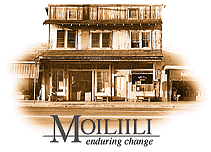 To outsiders, it's just a plain Jane area overshadowed by its Manoa neighbor, the University of Hawaii, or lumped with its border cousin, McCully.
To outsiders, it's just a plain Jane area overshadowed by its Manoa neighbor, the University of Hawaii, or lumped with its border cousin, McCully.
Its residential parts are a hodgepodge of weathered single-family houses and newer apartment highrises. Its main street is lined with ordinary one-, two- and three-story buildings, home to a host of multigeneration family business.
But to many older people who grew up there - especially those 60 to 80 years old, and even those in their 90s - it truly is what neighborhood historian Glen Grant calls a place of the heart.
"There are historic places, places of history, that are valued," reflected Grant, whose walking tour of Moiliili is one of many he offers through Honolulu TimeWalks. "But there are also places of the heart in a community and Moiliili has been filled with places of the heart for everyone - not just people who lived here but for people who always thought of Moiliili in certain ways."
 Rosilyn Akana, 8, with her dog waits for mom to finish work..
Rosilyn Akana, 8, with her dog waits for mom to finish work..
Kinji Kanazawa, born on the site of the old Honolulu Stadium on Isenberg Street 80 years ago next month, remembers when Moiliili was dominated by a quarry.
"I always used to say, once a person lives and smells the dust of the quarry, he'll always be a Moiliili person," he said.
Muriel Miura-Kamenaka grew up across University Avenue from that old Hawaiian Cement & Dredging quarry, now the UH's lower campus where the Special Events Arena and the baseball stadium stand.
As a teen-ager, she would walk down the hill to help her dad, Minoru, in his Kamada Store, in the space now occupied by Wah Fung Chinese Restaurant. The restaurant is in a two-story building, next to Puck's Alley, that also houses two other restaurants, plus Honolulu TimeWalks upstairs.
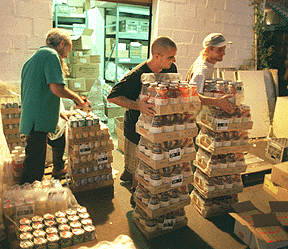
Chris Raelj, Leo Amador and Trevor Zara load up a
delivery behind the Natural Food store.
Another of her memories: Trekking over to Kuni Dry Goods every day to buy fabric.
Kamada, who was born at the Black Point home of Gov. George Carter nearly 89 years ago (his mother was a housekeeper there), remembers the building was "kind of old when I bought it." He was a roving fish-and-vegetable peddler before he plunked down "big money" - $12,000 - for the building in 1938. Kamada ran the grocery for awhile, then, in the 1950s, tried his hand at garment manufacturing upstairs. He eventually left Moiliili to go into real estate, then operated a jewelry concession at Woolworth's in Ala Moana Center until his retirement in 1975.
With that kind of family history, "I think of (Moiliili) in terms of endearment," said Miura-Kamenaka, 61, a cookbook author and retired Honolulu Gas Co. home economist.
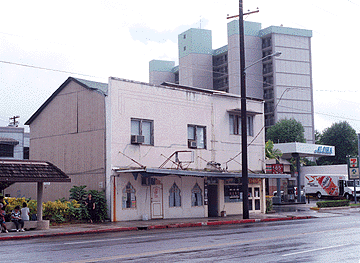
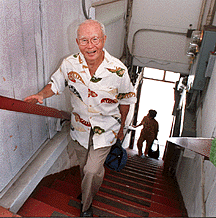 Left, Minoru Kamada, 88, climbs steps of the Kamada Building, which he built, one of the oldest buildings in Moiliili, above.
Left, Minoru Kamada, 88, climbs steps of the Kamada Building, which he built, one of the oldest buildings in Moiliili, above.
But to begin with, what exactly are the borders of Moiliili? Ask 10 people and you'll probably get 10 different answers, Miura-Kamenaka said.
A 1956 Star-Bulletin article noted, "It's impossible to try to fix any specific boundaries for this prominent residential and shopping district." But roughly, Moiliili is considered the area bounded by Isenberg Street, Kapiolani Boulevard down to the Ala Wai, Old Waialae Road and "no higher than Dole Street."
Before the turn of the century, Moiliili was home mostly to Hawaiians and Chinese. The area was covered with duck and lotus ponds, rice and taro paddies, banana and vegetable patches. Stocked with blooms that grew on farms skirting the neighborhood, Moiliili became known for its flower shops.
Abraham Piianaia, former Hawaiian Home Lands director and one of the founders of the Hawaiian Studies program at UH, grew up next to Mother Rice Pre-school.
He remembers when Kawaiahao Church had a branch - Moiliili Church - near Kuhio School.
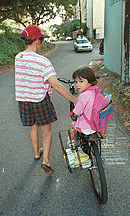 Kathy Hiratsuka picks up daughter Emi, 3, from Mother Rice preschool.
Kathy Hiratsuka picks up daughter Emi, 3, from Mother Rice preschool.
"I think Moiliili was one of more successful residential areas in town available to a mixture of ethnicities - Hawaiian, Japanese, Portuguese, Chinese. We all grew up having great respect for reach other," Piianaia, 81, said. "Some of my best friends all of my life were Moiliili boys and girls."
Historians can pinpoint the date, 1896, when the character and ethnicity of the neighborhood began to change. That's when Kihachi and Shika Kashiwabara moved to Hausten Street, where The Willows restaurant, now vacant, would be built. They later moved to the Star Market site, establishing a homestead known as Kashiwabara Camp.
In 1994, one of two banyan trees in Moiliili Triangle Park, adjacent to Star, was dedicated to the Kashiwabaras - the first settlers of Japanese ancestry in Moiliili and founders, in 1902, of Moiliili Japanese Language School.
The other banyan is named for Harry Yoshimura, now 92, for his work in helping to save the Moiliili Community Center.
One of Moiliili's most successful native sons is U.S. Sen. Daniel K. Inouye.
"When the Japanese moved to Moiliili they were just getting started and making an adjustment from plantation life to here," Kanazawa, a retired attorney, said. "They became shopkeepers, trades people, carpenters, service people." The shops reflected their culture and included a tofu factory, teahouse and okazu-ya.
The Japanese also brought strong religious and educational beliefs, Kanazawa said. The Moiliili Hongwanji Mission on University Avenue, built in 1906, and the Moiliili Japanese School became the cultural and social centers of the community.
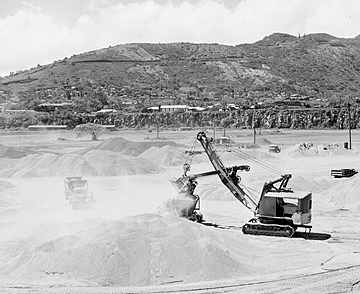
The University of Hawaii-Manoa parking garage and Special Events Arena now sit at the old Moiliili Quarry site. Tantalus is in the background. Special to the Star-Bulletin
The Japanese "needed company," is how Kanazawa explains the development of Moiliili into a close-knit ethnic community.
In later years, with the growth of the university and a change in zoning to allow apartment use, Moiliili evolved into a more ethnically diverse, transitory neighborhood, he said.
For a youngster like Kanazawa growing up there in the 1920s and '30s, it had the best of country and city living.
His first home was at King and Isenberg streets, kitty corner from Moiliili Field, once the recreational hub of the district. Eventually, Honolulu Stadium would be built there. Moiliili Field remains, but the stadium is long gone.
"If you live long enough, you can see one stadium built and demolished in your lifetime," Kanazawa mused, recalling the racket of the arena's construction in 1926, then its demolition 49 years later.
"Today, the place has no semblance of old Moiliili, which kind of saddens me," said Sidney Kashiwabara, 76, grandson of Kihachi and Shika. "The only thing that hasn't changed is old Triangle Park."
Kashiwabara, who still is a part-time dentist, has documented his family's years in Moiliili. In addition to his other achievements, his grandfather, Kihachi, is recognized as the pioneer of sumo in Hawaii, while his father, "Hans" Hankuro Kashiwabara, was the first nisei police officer in the Honolulu Police Department.
Kashiwabara remembers, "At 4 p.m. every work day, a low-pitched whistle would sound, signaling the blasting of the blue rocks in the quarry. The constant blasting over the years left the homes and everything else around coated with thick, white dust ... "
He also remembers mule teams hauling loads of gray aggregate to town, "much like the mule trains of Borax fame."
One of Kashiwabara's fondest memories: "Mr. Nishida owned a yellow hotdog wagon that he parked in an empty lot where Varsity Square is now located." Whenever he had a dime, he'd buy one of Mr. Nishida's "fat, juicy hotdogs bathed in French's mustard with a generous slice of dill pickle sandwiched in between...
"I do think of those days quite often," he said.
Glen Grant didn't grow up in Moiliili. But just in the seven years he's been offering his monthly "Mysteries of Moiliili" tour, so many things have changed.
"It's like your town vanishing right in front of you," he said: Chunky's (Drive-In); The Willows, Moiliili Store, the little green building by Kapaakea and King Street that was torn down ...Many of the structures of the Moiliili Japanese Language School, which was there when I started the tour, are gone."
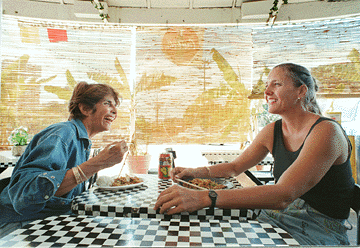
Owners of Old Waialae Road Conne Sutherland,
left and Liz Perry take a break.
"When you look on its surface, (Moiliili) appears to be a pretty typical urban middle-class community," Grant said. "But when you begin to take a look at its history and its stories and look beneath that surface, what you begin to uncover is a microcosm of the story of the people of Hawaii and the evolution of our multicultural environment.
"I try, on the walking tours, to touch that history by walking around the neighborhood and going to sites that 300 years ago, 200 years ago, were associated with tremendously fascinating (Hawaiian) legends, and which, 75 years ago, 60 years ago, was associated with one of our more important ethnic communities," Grant said.
WHEN: Saturday
Craft Fair, 9 a.m.-1 p.m., Kuhio School. More than 50 crafters, kids activities, plant sale, food & bake sale, country store, entertainment.
Moiliili Cemetery tour, 9-11 a.m., the cemetery gate on Kuilei Street behind Kuhio School. Led by Nanette Napoleon Purnell, $5 per person; 25 person maximum.
Journeys to old Moiliili, Honolulu TimeWalks; 50 cents, adults; 10 cents, children 10 and under.
- 9:30 a.m., Old Stadium Days, meet at the tables at Old Stadium Park
- 10:30 a.m., Sacred Pools of Moiliili, meet at old Willows restaurant, Hausten Street
- 11:30 a.m., Moiliili-The Japanese Story, meet in front of Moiliili Community Center office
- 12:30 p.m., Legend of Moiliili, meet at Kuhio School's banyan tree near South King Street
Japanese Cultural Center of Hawaii, 10 a.m.-4 p.m., free admission to gallery
Halloween parade, 5:30 p.m., sponsored by Kapahulu-Moiliili Lions Club. Starts at Kuhio School, ewa on South King, on to Beretania, makai on to Isenberg, left on to South King to Moiliili Community Center.
Halloween activities, 6-7:30 p.m., Moiliili Community Center
Parking: The Japanese Cultural Center of Hawaii at 2454 S. Beretania is offering parking for $2. Parking will also be available at Kuhio School, 2759 S. King St. or along the streets.